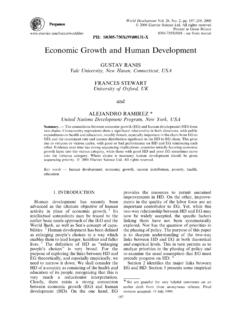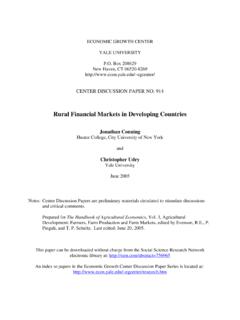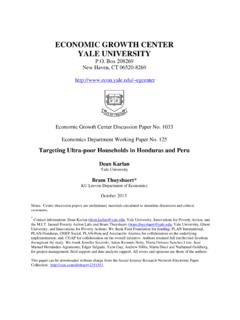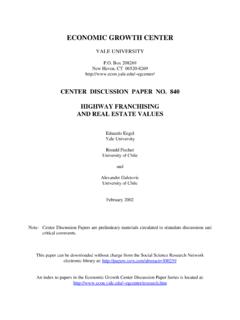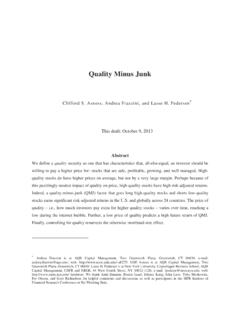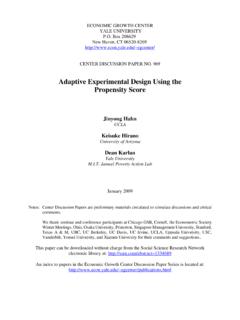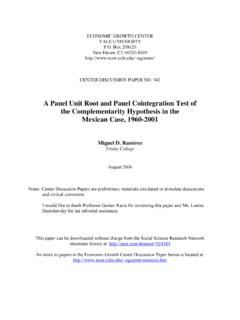Transcription of ECONOMIC GROWTH CENTER New Haven, CT …
1 ECONOMIC GROWTH CENTERYALE Box 20826927 Hillhouse AvenueNew Haven, CT 06520-8269 CENTER DISCUSSION PAPER NO. 766 supplier relations AND THE market context :A THEORY OF HANDSHAKESJohn McLarenColumbia UniversityOctober 1996 Note: CENTER Discussion Papers are preliminary materials circulated to stimulate discussionsand critical comments. Professor McLaren was a Visiting Assistant Professor in theEconomics Department at Yale University. The author is very grateful to Jeremy Bulow, Jay Choi, Rob Feenstra, and Chris Sanchirico*for very useful conversations, but none of these bears any blame for errors or relations and the market context : A Theory of Handshakes.
2 *John McLarenDepartment of EconomicsColumbia UniversityNew York, New York This paper provides an ECONOMIC theory of the degree of formality in industrialprocurement. The argument is based on a tension between two procurement goals: imposingcost discipline on the supplier , and creating the conditions for cooperative innovation. In thismodel, a contract can solve the cost discipline problem, but only by discouraging cooperation;a less formal arrangement provides cooperation but poor discipline. The attractiveness ofcontracts is smaller, the less vertically integrated the industry, because a thick market forinputs provides its own discipline incentives even without a , in highly integrated industries, contracts are used, while in less integrated industriesbusiness is done on handshakes.
3 This theory of the role of market context roughly fits somestylized facts and international comparisons, and may be a useful complement to somesociological Codes: L14; : Japan-US comparisons, Subcontracting, Cooperative innovation. Of course, this is a coarse generalization, and is meant to be taken as a relative can certainly be found, and as Macaulay (1963) pointed out, even the relativelylegalistic supplier relations in the US are rarely as formal as the text of the contract suggests. Norare these patterns frozen in time, as suggested by Helper (1991), Cusumano and Takeishi (1991),Dyer (1996), Johnston and Lawrence (1988) and others who document movements by USmanufacturers in the direction of the Japanese model, a topic that will be discussed in theconcluding section of this paper.
4 The literature on these comparisons is enourmous. For examples, see Clark (1989),2 Nishiguchi (1994), Dyer (1996), Cusumano and Takeishi (1991), and Liker et al. (1996). Thecontemporary textile industry of central Italy is also often discussed in terms that come closer tothe Japanese model than to the rest of Europe; see, for example, Johnston and Lawrence (1988). This stark choice is imposed for simplicity. In practice, of course, most industrial supply uses3some form of contract, and the question is how much structure it imposes on the tremendous diversity in relationships between industrial suppliers and theircustomers has long been noted by business analysts.
5 For example, it is often observed thattypically American and European supplier relations are litigious, with fixed-price contractsand little cooperation between supplier and purchaser, while their Japanese counterparts1exhibit relative informality, cost sharing, and paper argues that such differences may be partly explained by differences in thedegree of vertical integration in the industries concerned. The argument is based on a tensionbetween two goals a buyer may have in its outsourcing strategy: imposing cost discipline onthe supplier , and creating the conditions for cooperative innovation.
6 The argument will bemade in a model in which purchasers choose between a completely enforceable contract andnone at all. Very briefly, it will be argued that a contract tends to solve the cost discipline3problem but eliminate cooperation; non-contractual procurement, on the other hand, provides2 See Dyer (1996), for example. Generally outsourcing in either country does involve a written4contract specifying a price and other terms, but the standard Japanese outsourcing contract alsocontains a schedule for frequent renegotiation of that price (Asanuma, 1985a,b).
7 This, combinedwith the frequent absence of a blueprint as part of the agreement ( black-box arrangements; seeNishiguchi, 1994, pp. 129-30; Cusumano and Takeishi, 1991, pp. 572-3) means that the Japanesecontract can be seen as largely a framework for ongoing discussions. This is sometimes described as the sharing of reductions in cost at the margin or the sharing5of additional profit from cost savings at the margin. These are, of course, three ways of sayingthe same thing. See Liker et al. (1996, p. 77). Asanuma (1985a, b) discusses in some detail Japanese6procedures for allocating the burden of cost shocks between buyer and seller.
8 Cost-sharing iscooperation but only weak incentives for cost discipline. However, the more non-integratedfirms there are in the industry, the better cost discipline incentives without a contract are,because of the way bargaining power effects affect incentives. Thus, with a highly non-integrated industry, a non-contractual arrangement effectively solves both problems at once. The result is that in highly integrated markets, contracts are used, while in less integratedindustries business is done on handshakes. This is consistent with the observation that it is inrelatively vertically integrated economies (such as the North American and European) thatprocurement is at its most litigious, and vice versa for relatively non-integrated economies(such as Japan, and portions of central Italy).
9 To elaborate, it may be useful to identify three generalizations emerging from theempirical literature and case studies. First, Western supplier arrangements tend to be muchmore formal in the sense of relying on detailed written contracts and specifications thanJapanese ones, which use far less detailed contracts and often leave the final transactions priceto be worked out later. Second, Japanese supplier relations are much more likely than4 Western ones to make use of cost-sharing at the margin. Western industrial buyers are more5,63emphasized by Dyer (1996), who documents Chrysler s study and imitation of the Honda suppliersystem in the early 1990 s.
10 One of the key features is the equal sharing of the benefits of costreductions between buyer and supplier . Nishiguchi (1994, p. 6), in summarizing the strengths ofthe Japanese system, asserts that the establishment of rules to share fairly the profits fromcollaborative design and manufacturing has encouraged the subcontractors entrepreneurship andtheir own symbiotic relationships with their customers; see also pp. 126-8. For example, Dyer (1996, p. 52) discusses this in the case of Chrysler under the old system,7and Nishiguchi (1994, pp.)

